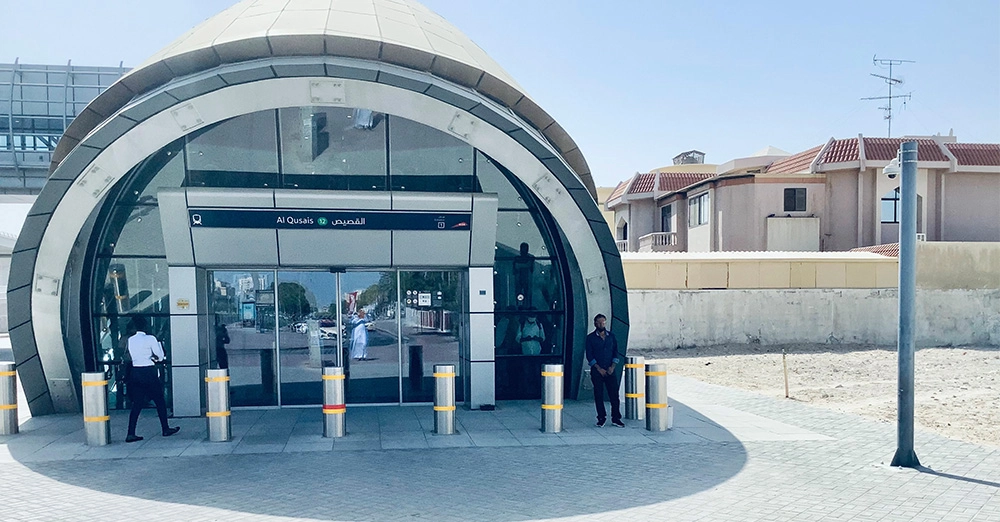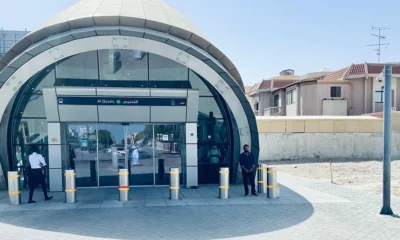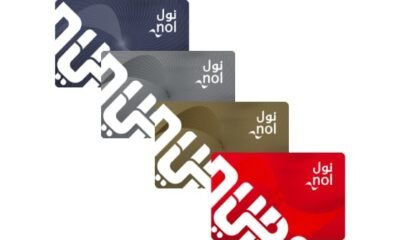Dubai Metro
Dubai Metro
The world’s largest automated driver-less train system, the Dubai Metro has left no leaf un-turned in transforming the journey of its passengers into an incredible experience.
In an endeavor to make Dubai the smartest and happiest city on Earth, the intelligent system has introduced latest technology and great features along with Nol cards, smart malls, WiFi connectivity and ATMs. Today, it has not only prioritized cost-effectiveness but also provided convenient means of travel, easy accessibility for disabled passengers, along with excellent connectivity to other public transport such taxis and buses,which made it one of the most popular, convenient and cheap modes of transportation in Dubai. It carries about 1.2 million passengers on an average day, and 355 million passengers a year. Designed to meet the highest environmental sustainability standards, it considerably contributes to the green environment by reducing carbon dioxide (CO2) emissions.
Dubai Metro Lines
1. Red Line
The Red Line, which runs from Rashidiya to UAE Exchange has 29 stations in between them. While construction of the line started in August 2005, it was opened for public on 9thSeptember 2009. The Red Line is 52.1km with 5km underground. The entire journey time on the Red Line is around 69 to 70 minutes, travelling at an average speed of 47 kilometres per hour. The Red Line has a main depot in Al Rashidiya and one auxiliary depot at Jebel Ali Free Zone.
2. Green Line
The Green line has 20 stations and spans from Etisalat to Dubai Creek. Initiated in July 2006 and opened on 9th September 2011, it covers 22.5 kilometres with 8 kilometres underground. With an average speed of 38 kilometres per hour, the entire journey time on the Green Line is around 40 minutes. Both lines meet at two interchange stations which are Union Station and BurJuman Station.
3. Route 2020 – A 15 km. extension with 7 new stations comprising 2 underground stations starts from Nakheel Harbour and Tower (Dubai Metro) to the expo 2020 site.
- Proposed Lines
Purple Line – It will cover 8 stations from Dubai International Airport to Al Maktoum International Airport.
Pink Line – It will run east to west with a terminus at Al Sufouh.
Blue Line – It will cover 18 stations along Mohammed Bin Zayed Road.
Yellow or Gold Line – It will connect Arabian Raches, Deira and Dubai Marina.
Dubai Metro Operating Hours
- Saturday to Thursday from 6am to 11pm
- Friday from 2pm to midnight
- During Ramadan – Saturday to Thursday from 6am to midnight
- During Ramadan – Friday from 2pm to midnight
Dubai Metro Speed and Frequency of Trains
The trains have a maximum speed of 90km/hr, forming a round trip of two hours and 23 minutes for the Red line and one hour and 23 minutes for the Green line. Depending on the hour of the day, trains run every 5 minutes during rush hours and every 8 minutes on normal hours
Dubai Metro Baggage Policy
2 suitcases are permitted per passenger. All luggages must be stowed in the dedicated luggage area, which can be found in each cabin.
- 1 x Large Suitcase with dimensions not exceeding 81cm x 58cm x 30cm
- 1 x Small Suitcase with dimensions not exceeding 55cm x 38cm x 20cm
Dubai Metro Usage Rules
- Pets are not allowed in the stations and trains.
- Smoking is forbidden in the Metro facilities.
- Large items like surf boards are restricted
- Eating and drinking on boarding a train is a byelaw offence.
- Elderly, injured, special needs people and pregnant women have the choice of priority seating.
- Fines are imposed for travelling in wrong cabins.
- Selling or promoting, in any way goods and commodities
- Damaging, vandalising or destroying equipment or seats
- Parking vehicles in areas designated for metro users for a period exceeding the permitted period.
- Spitting, littering, or performing any act that would compromise the cleanness of Public Transport and Public Transport Facilities and Services.
- Misusing lifts or escalators
- Boarding the Public Transport Facilities and Services by climbing or jumping
- Opening the doors or attempting to access or leave train while it is moving between stations and stops.
- Carrying hazardous items, including weapons, sharp tools or inflammable materials
Brief History of Dubai Metro
Dubai Metro, the first urban metro rail network to run in the Gulf’s Arab states was inaugurated by Mohammed bin Rashid Al Maktoum, the Ruler of Dubai on 9th September 2009. The first section known as Red Line, covering first 10 stations was incepted and opened to public on that day. The Green Line was opened on 9th September 2011. Today, the metro system has eased the daily commute for thousands of workers in the emirate. The Red and Green Line was built by Dubai Rapid Link (DURL) Consortium that comprises Japanese companies including Mitsubishi Heavy Industries, Mitsubishi Corporation, Obayashi Corporation, Kajima Corporation and the Turkish company Yapi Merkezi.
What’s special about Dubai Metro?
- Fully Automated Signalling and Communication System
The fully automated signalling and communication system is supplied by Thales Rail Signalling Solutions. With the control centre integrated at Al-Rashidiya depot, the automatic train control system allows headways of between 90 seconds and two minutes. While the communications system includes in-cab signalling, on-train video surveillance, passenger information, public addresses display in English and Arabic, LED systems and Wi-Fi, emergency call boxes are fixed in the trains for safety measures.
- Three Classes of Train Service
Each train has 5 carriages and each carriage is divided into 2 cabins. Seating arranged in a variety of ways, giving passengers the choice between Windows views and chatting with friends
- For women and children, there is a special 12 seat car consisting of 3 flip up chairs and with more space to allow strollers and bags.
- Gold class cabin is equipped with 18 deluxe seats located at the front of the train. This VIP cabin is more spacious with a higher level of privacy, luggage space and leather seating.
- Silver or Standard class has standard seating arrangement for 25 to 27 seats in a combination of blues and greens.
Facilities for the Physically Disabled
There are special facilities for the physically disabled. Station staff is trained as first aiders and there are first aid rooms in stations.
- Contrasting tactile guidance path to guide the visually impaired
- Clear way finding signage
- Dedicated spaces for wheelchair users
- Ticket counters within easy reach for wheelchair users
- Dedicated toilets for physically disabled
- Lift access to all station levels
- Platform alerts like audible bleeps on closing doors and flashing signals
Going Smart with Wojhati App
The Wojhati App launched by RTA in 2013, allows users to view routes, major landmarks, stops and departures, and helps plan journeys using metro routes. While upgrading its mobile services, the RTA has also introduced 5 Smartphone applications that included Public Transport app.
- One Card for All – Nol
To bring in an integrated automated fare collection card, the RTA introduced the Nol card. It is an electronic ticketing card that holds prepaid funds to pay for fares on trains. Passengers swipe on and swipe off their cards on electronic gates when entering and leaving the metro to validate it or deduct funds. These prepaid cards can be topped-up online, at ticket machines or at ticketing offices by cash, credit and debit cards. Designed to reduce the number of transactions at ticket counters and the number of paper tickets, the Nol card offers cheaper fares than the paper ticket option even though you have to purchase it.
- Free Parking
Dubai Metro offers free multi-level car parking with an estimated capacity to accommodate more than 8,000 vehicles. Fines are imposed for leaving vehicles overnight.
- Rashidiya Metro Station on red line – 2700 cars
- Nakheel Harbour and Tower Metro Station on red line – 3000 cars
- Etisalat Metro Station on Green Line – 2300 cars
- Smart Malls at 4 Metro Stations
The smart mall concept at Dubai Metro was rolled out by RTA in alliance with Etisalat. The first of its kind globally, the smart malls offer commuters a unique shopping experience via an interactive, high-definition 3D digital screen that spans over 9 sq metres. Customers can pick from the items on show by adding them to the shopping cart and paying by credit cards. All goods are delivered at the time and place specified by the customers.
- Dubai Metro Museum
Islamic Art and Arabic Calligraphy Museum displays historical manuscripts, ceramics, jewellery, calligraphy paintings from 1400 years of Islamic history.
Inventions Museum offers interactive and educational displays of inventions from various fields like astronomy, engineering, geography, mathematics and medicine.
Contemporary Art Museum is a collection of modern art from contemporary artists including paintings, designs, graphic illustrations, and models.
Visual Art Museum displays contemporary visual art including movies, documentaries, cultural and artistic multimedia creations.
- Integration with Dubai Tram
The Dubai Tram integrated with Dubai Metro at the Dubai Marina and Jumeirah Lake Towers stations in 2014. Footbridges are now connected creating a direct link between the two adjacent tram and metro stations for a smooth and seamless interchange for passengers between the two systems.

Dubai Metro
Al Qusais metro station

Al Qusais (Arabic: اﻟﻘﺼﻴﺺ) is a rapid transit station on the Green Line of the Dubai Metro in Dubai, United Arab Emirates, serving the Al Qusais and Al Twar areas in Deira.
The station opened as part of the Green Line on 9 September 2011.
It is close to the Al Salam Community School (ASCS) and the Al Qusais Police Station. The station is also close to a number of bus routes.
| Location | Al Nahda Road Al Qusais, Deira, Dubai United Arab Emirates |
|---|---|
| Coordinates | 25.262625°N 55.387414°E |
| Operated by | Dubai Metro |
| Line(s) | Green Line |
| Platforms | 2 |
| Tracks | 2 |
| Other information | |
| Station code | 12 |
| Fare zone | 5 |
| History | |
| Opened | September 9, 2011 |
| Services | |
| Preceding statio nDubai Metro Following stationDubai Airport Free Zonetowards Creek Green Line EtisalatTerminus | |

Al Ghubaiba (Arabic: الغبيبة, Arabic pronunciation: [al ɣʊ ˈbej ba]) is a rapid transit station on the Green Line of the Dubai Metro in Dubai, UAE.
The station opened as part of the Green Line on 9 September 2011.
Location
The station is located in Al Shindagha, Bur Dubai, traditionally the historic centre of Dubai. It is near the junction of 51 Road & Al Ghubaiba Road, with a number of entrances/exits.
It is close to Al Ghubaiba Bus Station (which has intercity services including to Abu Dhabi and Sharjah) and City Centre Al Shindagha, as well as Dubai Creek. It is also close to several bus services.
| Platform | Line | Destination |
|---|---|---|
| Al Fahidi platform | ■Green Line (Up) | For Union, Stadium, Etisalat |
| Oud Metha platform | ■Green Line (Down) | For BurJuman, Dubai Healthcare City, Creek |
| Location | 51 Road & Al Ghubaiba Road Al Shindagha, Bur Dubai, Dubai UAE |
|---|

Sharaf DG (Arabic: شرف دي جي, Arabic pronunciation: [shrf di’ji]; formerly Al Fahidi) is a rapid transit station on the Green Line of the Dubai Metro in Dubai, UAE.
Location
Located at the edge of the historic core of Dubai, Sharaf DG station lies underneath the intersection of Khalid bin Waleed Road and Al Mankhool Road. Nearby attractions include the Grand Mosque, the Dubai Museum, and numerous hotels. It is also close to Al Seef (with a Marina Transport Station on Dubai Creek), the Old Textile Souk, and the Sheikh Mohammed Centre for Cultural Understanding.
History
Sharaf DG station was renamed from Al Fahidi on 24 November 2020. Mashreq station was formerly called Sharaf DG until 18 May 2020.
Sharaf DG station opened along with the initial stretch of the Green Line on 9 September 2011, with trains running from Creek to Etisalat. In December 2012, the RTA announced that Al Fahidi saw the highest ridership of all Green Line stations since opening in 2011, with 5.232 million passengers.
As with other stations in Dubai’s historic centre, Sharaf DG is an underground station, with tracks and platforms situated below Kalid bin Waleed Road. There are two side platforms and two tracks, with access to the station from all four corners of Khalid bin Waleed Road’s intersection with Al Mankhool Road. Sharaf DG’s colour scheme is characterised by the use of bright red tiles, symbolising the element of fire; other Dubai Metro stations take inspiration from fire as well as air, water and earth.
| Platform | Line | Destination |
|---|---|---|
| Platform 1 | ■Green Line (Up) | For Union, Stadium, Etisalat |
| Platform 2 | ■Green Line (Down) | For BurJuman, Dubai Healthcare City, Creek |











